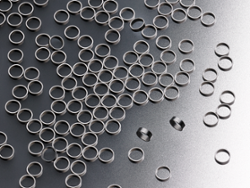The Light Bulb Goes Off — New Ideas for Using Tungsten Wire Are Born!
Unlike the incandescent light bulb, tungsten wire is not going away any time soon. In fact, like modern lighting, tungsten wire continues to evolve as a material whose uses are growing — for example, in medical technology (medtech).
Tungsten wire has been used in medical devices for many years and continues to be invaluable in medical applications where electric current is utilized and where precision is critical. For instance, tungsten wire is a great material for the medical technique of cauterization, which is used to mitigate bleeding, remove an undesired growth, and other similar purposes.
Electrocauterization: A High (Temperature) Wire Act
Cauterization is the burning of biological tissue to remove or close off a part of that tissue. The main forms of cauterization used today are electrocautery and chemical cautery, and it is the former for which tungsten wire is a proven asset.
Not to be confused with electrosurgery, electrocautery generally uses a metal probe that is heated by electric current to a dull red glow. The probe is then applied to the targeted tissue to, for example, stop bleeding from small vessels or cut through soft tissue.
For electrocauterization, tungsten wire can be used in the form of straight probes that can be made as a tapered, solid probe. Or, lengths of the material can be curved into a tungsten wire loop that acts as a cutting tool.
With the highest melting point of any known metal, tungsten has the ability to hold its shape and not flex or deform at the temperatures the procedure requires in order to efficiently cut and cauterize tissue.
Similarly, a tungsten electrode is often a component of minimally invasive surgical ablation devices, which use high temperatures for tissue removal. For instance, in cardiac ablation, tiny areas of heart tissue are cauterized to adjust the heart’s own electrical impulses and help to regulate the heart rate.
Electrosurgery: Alternate (Current) Procedures
Tungsten wire is also useful in electrosurgery, not just where it overlaps with electrocautery, but also for stimulation and probing.
Electrosurgery applies high-frequency electric current directly to biological tissue, allowing surgeons to precisely cut, coagulate, desiccate, or remove tissue with limited blood loss. The method is used in hospital and outpatient settings for a wide range of general and specialized surgical procedures.
Where electrocautery uses heat conduction from a probe heated by a direct current, electrosurgery devices use alternating current to directly heat the tissue itself.
Similarly, electrostimulation — a technique used in physiotherapy and pain management — uses a device to apply electrical pulses directly to motor nerve or muscle fibers. As with electrocauterization, the heat resistance property of tungsten wire is a huge advantage in electrosurgical procedures.
Use of Tungsten Wire in Neural Probes
For the purposes of stimulation and probing, where the diameter of the wire must be incredibly small and narrow, the benefits of tungsten wire are also evident. For example, if you are making a neural probe, there are three critical issues:
- The probe must reach the area to be examined or treated from a distance, without getting too close and moving or disturbing a surrounding tissue.
- As with any brain surgery, the smallest possible incision or opening is the goal.
- While true for all surgeries, a brain procedure needs to be exactly on target. There is no such thing as missing by “a little bit.”
Far more than any other metal and despite not being a particularly conductive material, tungsten wire at a small diameter and long length maintains its straightness and shape — characteristics that are vital for directional accuracy in neural probes and similar devices.
Added Benefits of Tungsten Wire in Medical Devices
Tungsten wire’s high tensile values also make it useful in medical devices. For instance, when making a steerable guide wire for minimally invasive surgery, even specialty stainless steel — with its remarkable mechanical properties — is limited. But tungsten wire and its tensile strength give engineers new values to work with and expand the possibilities beyond the range of stainless steel.
Another added bonus is tungsten’s density: It is equal to that of gold, just below platinum and iridium, well above palladium and other supposed precious metal replacements, and certainly superior to any of the ferrous alloys, including stainless steel.
Tungsten’s high density makes tungsten wire very radiopaque, allowing it to have additional uses in minimally invasive devices whose pathways are only visible on fluoroscopes.
An Essential Material for Medtech Innovation
It is safe to say that for medical device applications requiring heat resistance, precision, and the ability to maintain straightness, shape, and direction, tungsten wire is a proven asset to medtech engineers and manufacturers — and to physicians and patients, whether they know it or not!
Metal Cutting’s long history of serving the medical device industry and our commitment to innovation help us stay ahead of the curve when it comes to meeting the needs of customers in this market, for tungsten products as well as for precision cutoff, grinding, lapping, machining, and finishing of small metal parts.
To learn more tungsten wire and many of its other unique and interesting uses, download our free guide to its properties and applications.






